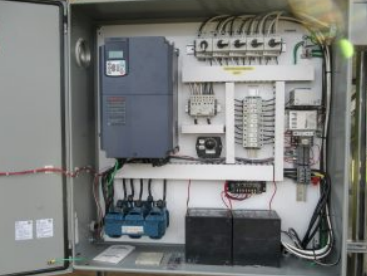Variable Frequency Drive (VFD) Pump Panels for California AG

Running your motors with a VFD, Variable Frequency Drive, will save energy costs, protect your investments, and improve control over your systems. Throttling down the speed of the pump or fan just a few Hz reduces the power it consumes drastically. The upgrade is a no-brainer when you consider that it pays for itself in about 1-2 years in Energy savings alone. With a VFD the pump gradually ramps up saving your pump from high starting torques and current surges. By adding controls your system will run more seamlessly and efficiently. All of our VFD panels have line reactors on the line and load side of the VFD to protect the motor and VFD voltage spikes or imbalances. It’s straight-forward, having a VFD translates into savings.
The first and most quantifiable saving is in the reduction of energy costs. 85% of the cost of pumps, compressors, or fans is not the purchase cost but the energy they consume in their lifetime. The affinity laws express the relationship between variables involved in pump or fan performance and power. Where pressure is the square of shaft speed, power consumed is the cube of shaft speed. A pump running at 90% of its maximum speed uses 30% less energy. At 63% speed a motor load consumes only 25% of its full-speed power.
In most situations irrigation pumps are oversized to ensure that it will have enough volume and pressure to do the job. By adding a pressure sensor the well pump or centrifugal pump can operate at a set pressure allowing it to work only as hard as it needs to maintain the desired pressure. When valves are opened or closed the pump speed changes to maintain the set pressure. Running the irrigation system at a set pressure or flow rate saves energy, reduces wear on the pumps and filters, and operates the sprayers, micro sprayers or emitters at the optimum pressure.
Our panels provide both mechanical and electrical protections that extend the life of the motor. Recently we installed a VFD panel for an existing 3hp pump that is being used in a pressurized system to wash produce. In this particular case the issue was that the grid is not consistent where their farm is located. The voltage spikes and lack of proper electrical protection burned their pump and they had had to replace the pump in that well several times. The panel we installed will protect their investment. Right away our client was surprised with the difference. Previously the plumbing would shake in a jolt when the pump came on now you can hardly tell. After a few weeks of operation they saw the reduction in energy costs.
Cost Example: A 30 to 40% energy savings is common when upgrading an irrigation pump with a Variable Speed Drive. A 20 HP pump that costs $18,000 per year to run can save $6,000. Depending on the VFD panel it can costs $8,000 to $10,000 plus installation. The energy saving alone pays for the upgrade without taking the labor and equipment saving into account. This being said, there are incentives available through the USDA NRC EQIP and PG&E. We can help your company navigate through the entire process and take care of the installation and paperwork. Contact us today for a Farm Efficiency Consultation.
AUTOMATION AND SENSORS
Pressure transmitter: The pressure transmitter senses the pressure in the line and sends an analog output signal the VFD. The Variable Frequency Drive can be programmed to maintain a set pressure.
Flowmeter: A flowmeter with an analog output signal measures the flow rate of an irrigation line and outputs a 4 to 20 mA or 0 to 10 Volt signal to the VFD. The Variable Speed Drive can be programmed to maintain a set flow rate.
Irrigation controller: the VFD can be connected to an irrigation controller to further automate the system. The Irrigation controller will turn the pump on when the irrigation zone valve or valves are opened.
Telemetry: The sensors and controller can be connected to a cellular logic controller allowing the irrigation to be view and controlled from a smartphone or computer.